Print advertising is one of the oldest forms and has an advantage over digital advertising. Although the market is moving towards digital advertising, it is still relevant and an inherent part of many brands' cohesive advertising strategies.
In this blog we'll explore print advertising in depth and see how to create an effective print ad step by step.
What is Print Advertising?
In simple words, The ads published on a paper medium by the advertisers are known as print advertising. It is traditional advertising that uses physical print media to promote a brand’s product or services.
Its history goes long back to when the only advertising medium was predominantly word of mouth.
Most commonly used examples of Print Advertising are -
- Newspapers
- Magazines
- Brochures
- Billboards
- Flyers
They have been used for circulating news pieces, editorials, and advertisements.
Also Check: Green Marketing - Its Benefits & Strategies that Brands use
Why Should You Still Consider Print Advertising in 2025?
Despite the numerous benefits offered by digital advertising, print advertising still has many unique advantages that can be leveraged with a full-fledged strategy. Let’s see some of the benefits here:
1. It Builds Brand Credibility and Trust
Newspapers and magazines are a regular source of news and articles in many households today. They are mostly consumed by people who find digital media challenging or distracting.
Print advertisements are considerably regarded as more reliable and easier to trust, as they offer a personalized experience when users read them on paper.
2. It's More Memorable Than Digital Ads
Print ads leave a long-lasting impression on the mind. It draws the reader’s attention through its catchy headline or appealing imagery and allows it to be read multiple times due to its tangible nature.
Data shows that print ads have an average response rate of 9%, while digital channels like social media, sponsored search, and email have an average response rate of about 1%.
3. You Get Full Control Over Placement and Targeting
With printable ads, brands leverage the flexibility of ad placement, budget, and audience targeting. They can choose the magazine, newspaper page, or billboard location to ensure the ad reaches the right target audiences.
Print advertising also supports precision targeting, ensuring the ad is viewed by people who are most likely to be interested in that niche product/service.
4. Works Great for Local Businesses
Print advertising often outperforms digital advertising when it comes to targeting local audiences. Brands can easily spread awareness or drive traffic on their websites through print ads in the local newspaper or with a flyer. Any exciting new product or offer immediately grabs attention when displayed on billboards, newspapers, and monthly magazines.
What Are the Different Types of Print Advertising Formats?
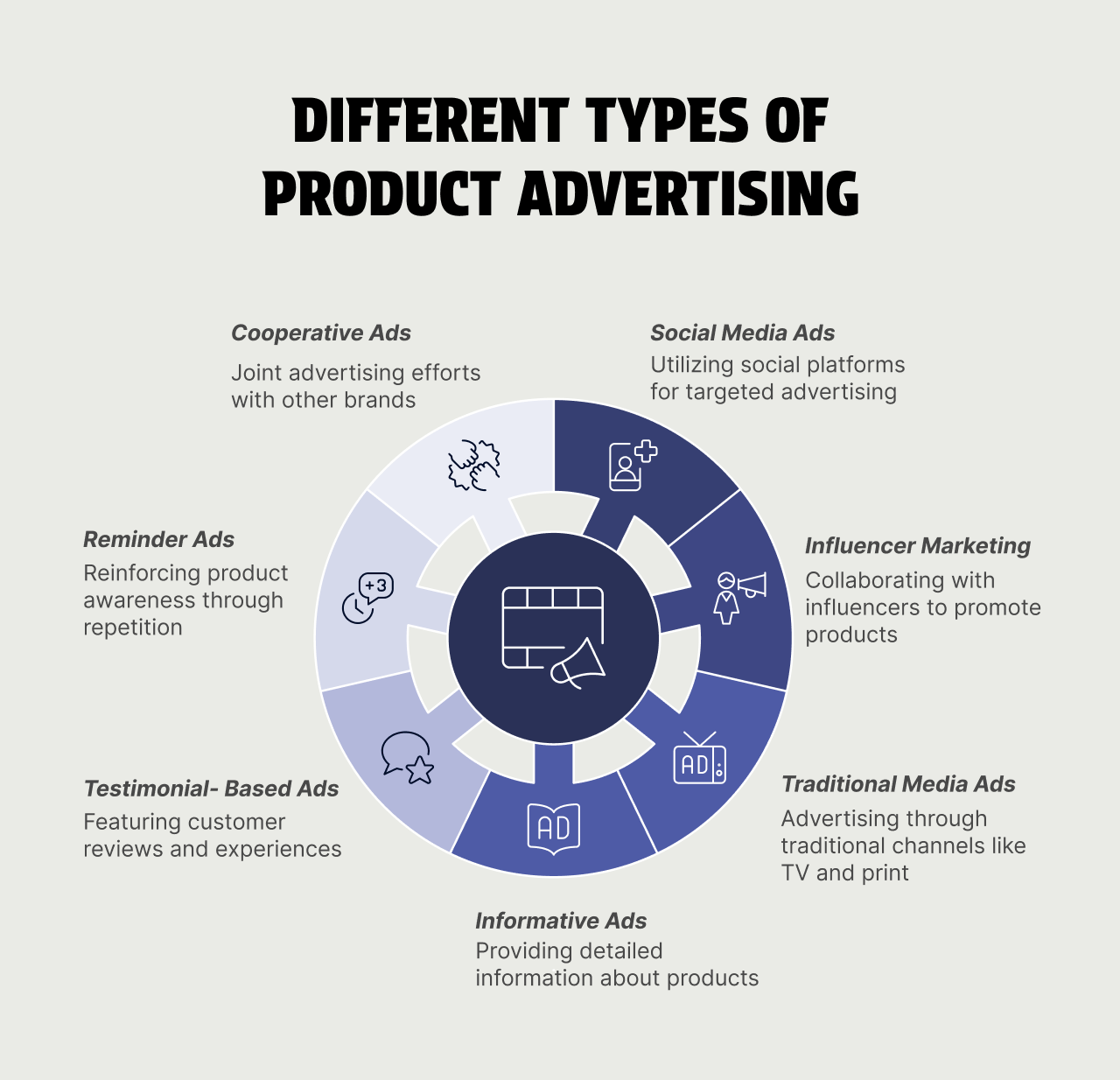
1# Newspaper Ads : Best for Local Reach
Newspaper ads have the potential to reach a wider audience from local communities. Big brands can use these mediums effectively to spread awareness among customers. Advertisers can choose different pages and classified sections for their print ad placement.
2# Magazine Ads : Niche Focused
Magazine ads are niche-based advertising in which a brand advertises in a particular magazine whose reader base is relatable to its products/services.
For example, a beauty and wellness brand can advertise in a magazine like Cosmopolitan, Vogue, or Femina, as the targeted audience contributes the most to reading these magazines.
3# Billboard Ads
Big brands often use this form of print advertising to grab quick attention. These large ads are displayed in metropolitan cities to target a large number of people. They are a powerful form of outdoor advertising in which brands incorporate motion pictures and 3D designs for an immersive experience.
4# Flyers/Brochures : Budget Friendly
Brochures are used as direct mailers or handouts to promote local businesses quickly. They contain all the necessary information and may be shared with hundreds of individuals at once. Brochures/flyers are also one of the least expensive ways to advertise your brand locally.
How to Create a Successful Print Ad Campaign (Step-by-Step)
A successful print advertising campaign does more than just take up space; it captures the attention of your target audience, conveys a clear message, and stays with them.
Let's deep dive into the process of creative printable ads that stand out across all formats:
Step 1: Start With a Clear Advertising Goal
The first and foremost step in developing an impactful print advertising strategy is setting a clear goal. The goal can be spreading awareness of newly launched products or upcoming sale events, attracting store traffic, or even generating sales.
Step 2: Understand Your Target Audience Inside-Out
It’s crucial to study the target audience for any advertising campaign. It will help design and distribute the ads as per the audience’s preferences. Some of the factors that must be taken into account before placing or distributing the ads are:
- Local Region
- Age group and gender
- Income and Job Type
- Interests
- Buying behavior
Step 3: Brainstorm Creative Ideas That Grab Attention
An ad is not just a piece of information; it’s a culmination of creative ideas and catchy taglines with a proper call to action. Each step requires brainstorming for making a print ad that stands out among competitors’. Print ads have four essential elements to them:
- Headline: It’s the first thing that readers engage with. It needs to be short, crisp, and eye-catching so that it appeals to them to know more about the ad.
- Body: The next element is where advertisers can put more details about the ad. It also needs to be elaborative so that readers get the gist behind the ad. The font selection matters a lot.
- Visual elements: This acts as a total game changer for any ad. The chosen image should convey the message behind the ad and reflect the brand image. Brands apply the color psychology phenomenon to make an impression.
- CTA: Readers should know what needs to be done after seeing the ad. This is where a clear and concise call to action is placed. It can be a website visit, a store visit, or a call now.
Step 4: Choose the Right Placement for Maximum Impact
Decide the ad design layout and mediums where the ads will be displayed. The ads should be balanced and easy to read in any medium. Placing the advertisement where the intended audience is likely to see it, whether that be in a specific magazine section or a busy area for posters, is important.
Step 5: Measure Results With Trackable Tools
Although print advertising doesn't offer the same real-time data analytics feature as digital ads, it's still essential to monitor the outcome. To track the effectiveness of the campaign, the brand may utilize visits from a particular area, use of unique promo codes, QR codes, or calls on dedicated phone numbers. This aids in improving the results of subsequent print campaigns.
Benefits of Creating Effective Print Ads
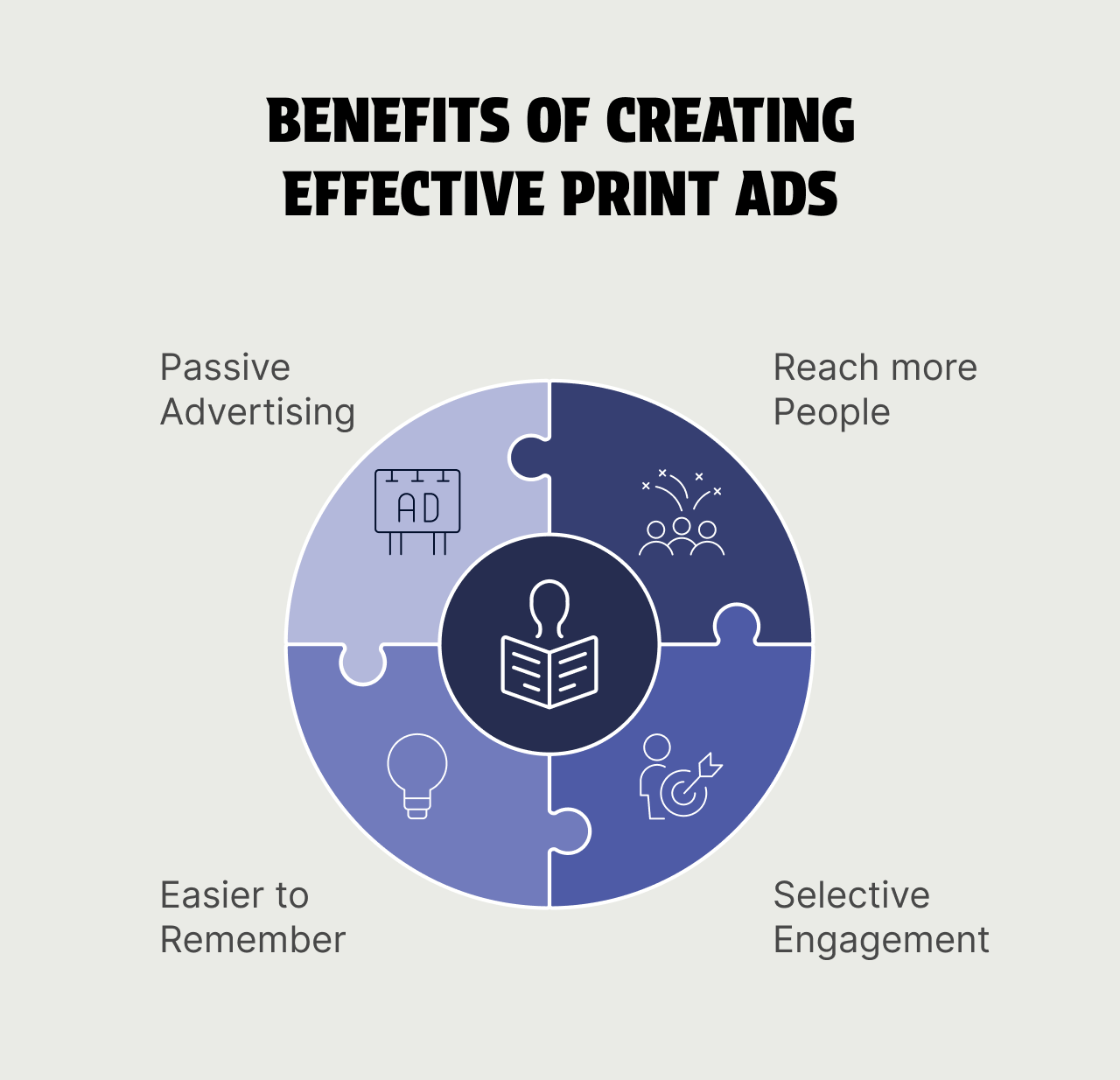
You Reach More People Offline
Print ads in newspapers, posters, and magazines reach a vast number of people at once. It is a great way for any new brand to get recognition in the market. Brands that are looking for awareness and consideration as a goal in an offline medium, print advertising is for sure a viable option for marketers.
Offers a Non-Intrusive, Personalized Experience
Unlike digital ads, print ads are less intrusive to the reader. They can engage with print ads based on their choice, time availability, and pace. This makes the ad engagement experience a bit personalized and noteworthy, which often stays for a longer period.
Print Ads are Easier to Remember and Recall
Newspapers and magazine readers make deliberate choices to read, which increases their attention span. Print advertisements like billboards, posters, and newspapers can be seen multiple times by the same user, which makes remarketing easier without putting in any extra effort.
Acts as a Powerful Passive Advertising Tool
A marketing campaign's total impact is increased when both online and offline advertising complement each other. It is a form of passive advertising that complements the integrated marketing strategy for a brand very well and ensures that the message reaches the audience through different mediums.
What Are Some Real-Life Examples of Creative Print Ads?
1# Coca-Cola: Recycle Campaign
"Recycle Me" presents a sequence of pictures showing the Coca-Cola logo followed by the crushing of a can. With the "Recycle Me" call to action displayed directly on the can's side, this self-explanatory ad raises awareness of recycling and motivates consumers to take constructive action after drinking a Coke can.
It is one of the best print ad examples you’ll see on the internet.

2# Nike: NYC Marathon Campaign
Nike's campaign demonstrated the effectiveness of contextual advertising at Whitehall Terminal, NYC. They made sure that their campaign was felt as well as seen by picking the ideal spot, utilizing strong imagery, and positioning their message in a busy area.
Both runners and commuters were drawn in by Nike's use of striking, dynamic graphics, which complemented the setting at Whitehall Terminal.

3# Starbucks "Green Opening” Campaign
Starbucks proposes 6,000 greener stores in over 40 regions worldwide, including India, Hong Kong, Indonesia, Malaysia, and New Zealand. This was an awareness campaign demonstrating an eco-friendly and sustainable approach towards our planet on a global level.

4# Motorola “Designed By You” Campaign
It was the first interactive print design campaign in the world. The company used an interactive ad in Wired magazine to further emphasize the customizability message by fusing a low-tech setting with a high-tech idea, which led to a change in the color of their displayed phone. Even the color of the camera ring can be customized to the user's preferences.
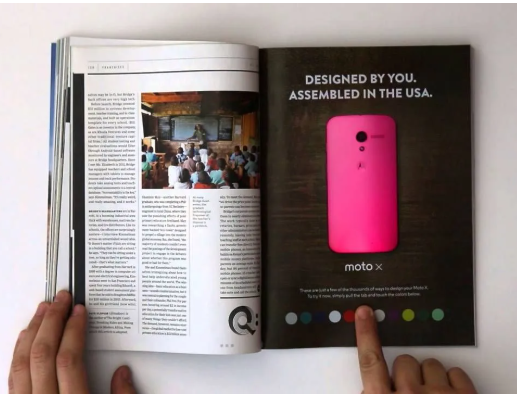
5# KFC Finger Lickin’ Good Campaign
This campaign was created to promote its iconic KFC buckets of fried chicken and its sides, establishing the bar that "good" food should be "Finger-Lickin' Good." They changed the tagline in times of COVID-19 to promote good hygiene with smart utilization of their print ads.
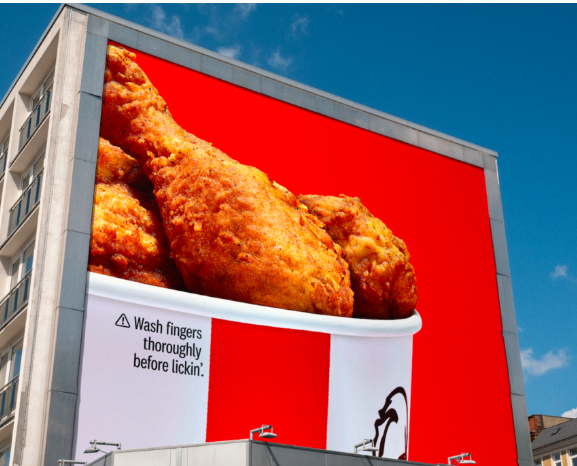
6# Amul Coldplay Campaign
Dairy brand Amul brings creative campaigns based on current events from time to time in India. Recently, they created doodles for Coldplay and their fans. This was an engagement campaign for fans to not get disappointed with the sold concert tickets.
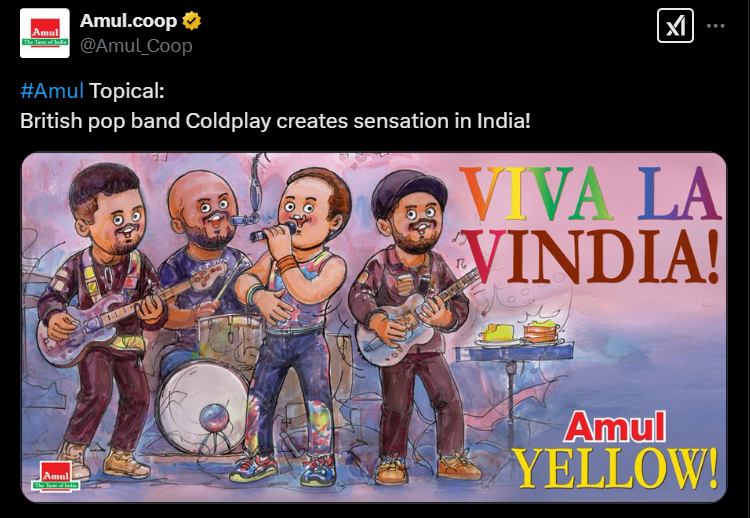
7# IKEA Bollywood Campaign
IKEA launched an engagement campaign by keeping location in mind. By referencing well-known Bollywood films, the "Bollywood Billys" campaign sought to establish a familiar connection with the Indian audience.

After seeing some of the great examples of print advertising in history, let’s know what future it holds.
What Is the Future of Print Advertising?
Print advertising is not going away, even though digital advertising has shown unprecedented growth in the last few years. It still plays a significant role in marketing plans, particularly for companies looking to establish a closer relationship with their target market.
These are the ways print advertising is going to take shape in the future:
Adapting to Digital Technology
Many brands have incorporated digital tech by using QR codes, augmented reality, digital sensors, and NFC (Near Field Communication) in their print campaigns. Embedding technology can bridge the gap between online and offline modes of advertising.
Improved Tracking
One of the major disadvantages of print advertising is that it’s not data-friendly; one can’t measure the outcome of the ad. Using data-driven techniques like URL, clicks, or phone number tracking can make the ads much more effective.
Innovative Designs
DOOH, 3D, augmented reality, and gamified ads in terms of image/video are going to rule in the next decade. New York Times Square broadcasts many of the innovative ads on 3D billboards.
Final Thoughts
Yes - and even more if combined with digital.
Print advertising offers a distinctive and memorable approach to engaging with your audience, from credibility and trust to targeted reach and enduring impressions. Print advertising can be used with digital marketing to produce a dynamic, multi-channel approach that improves your brand's visibility and drives faster results.
